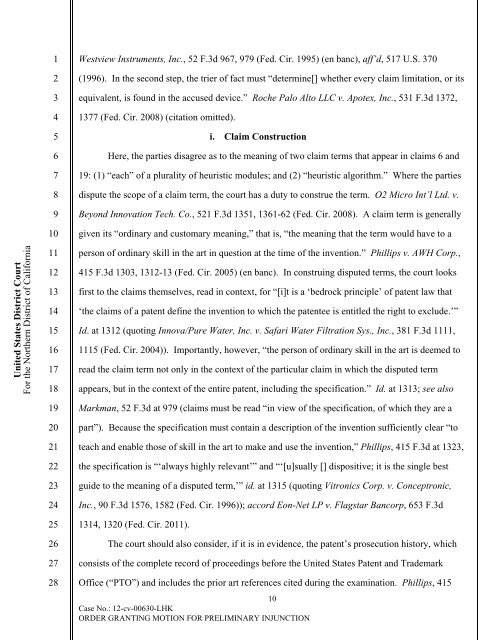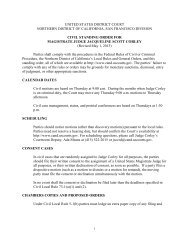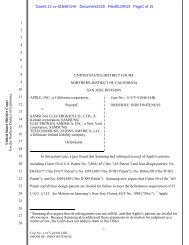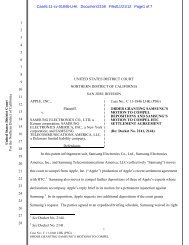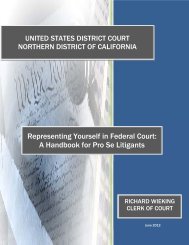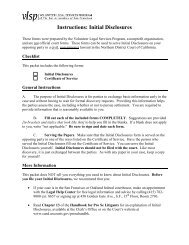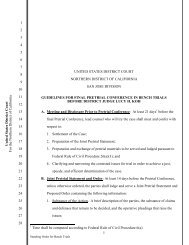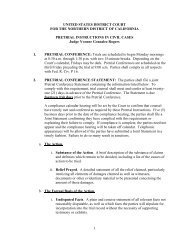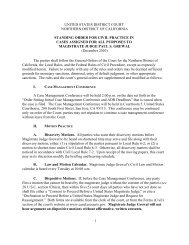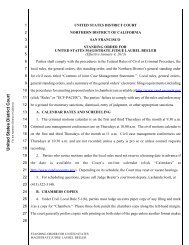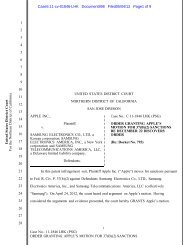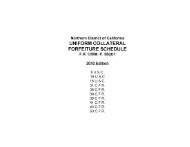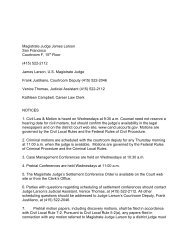Order Granting Motion For Preliminary Injunction - United States ...
Order Granting Motion For Preliminary Injunction - United States ...
Order Granting Motion For Preliminary Injunction - United States ...
You also want an ePaper? Increase the reach of your titles
YUMPU automatically turns print PDFs into web optimized ePapers that Google loves.
<strong>United</strong> <strong>States</strong> District Court<br />
<strong>For</strong> the Northern District of California<br />
1<br />
2<br />
3<br />
4<br />
5<br />
6<br />
7<br />
8<br />
9<br />
10<br />
11<br />
12<br />
13<br />
14<br />
15<br />
16<br />
17<br />
18<br />
19<br />
20<br />
21<br />
22<br />
23<br />
24<br />
25<br />
26<br />
27<br />
28<br />
Westview Instruments, Inc., 52 F.3d 967, 979 (Fed. Cir. 1995) (en banc), aff’d, 517 U.S. 370<br />
(1996). In the second step, the trier of fact must “determine[] whether every claim limitation, or its<br />
equivalent, is found in the accused device.” Roche Palo Alto LLC v. Apotex, Inc., 531 F.3d 1372,<br />
1377 (Fed. Cir. 2008) (citation omitted).<br />
i. Claim Construction<br />
Here, the parties disagree as to the meaning of two claim terms that appear in claims 6 and<br />
19: (1) “each” of a plurality of heuristic modules; and (2) “heuristic algorithm.” Where the parties<br />
dispute the scope of a claim term, the court has a duty to construe the term. O2 Micro Int’l Ltd. v.<br />
Beyond Innovation Tech. Co., 521 F.3d 1351, 1361-62 (Fed. Cir. 2008). A claim term is generally<br />
given its “ordinary and customary meaning,” that is, “the meaning that the term would have to a<br />
person of ordinary skill in the art in question at the time of the invention.” Phillips v. AWH Corp.,<br />
415 F.3d 1303, 1312-13 (Fed. Cir. 2005) (en banc). In construing disputed terms, the court looks<br />
first to the claims themselves, read in context, for “[i]t is a ‘bedrock principle’ of patent law that<br />
‘the claims of a patent define the invention to which the patentee is entitled the right to exclude.’”<br />
Id. at 1312 (quoting Innova/Pure Water, Inc. v. Safari Water Filtration Sys., Inc., 381 F.3d 1111,<br />
1115 (Fed. Cir. 2004)). Importantly, however, “the person of ordinary skill in the art is deemed to<br />
read the claim term not only in the context of the particular claim in which the disputed term<br />
appears, but in the context of the entire patent, including the specification.” Id. at 1313; see also<br />
Markman, 52 F.3d at 979 (claims must be read “in view of the specification, of which they are a<br />
part”). Because the specification must contain a description of the invention sufficiently clear “to<br />
teach and enable those of skill in the art to make and use the invention,” Phillips, 415 F.3d at 1323,<br />
the specification is “‘always highly relevant’” and “‘[u]sually [] dispositive; it is the single best<br />
guide to the meaning of a disputed term,’” id. at 1315 (quoting Vitronics Corp. v. Conceptronic,<br />
Inc., 90 F.3d 1576, 1582 (Fed. Cir. 1996)); accord Eon-Net LP v. Flagstar Bancorp, 653 F.3d<br />
1314, 1320 (Fed. Cir. 2011).<br />
The court should also consider, if it is in evidence, the patent’s prosecution history, which<br />
consists of the complete record of proceedings before the <strong>United</strong> <strong>States</strong> Patent and Trademark<br />
Office (“PTO”) and includes the prior art references cited during the examination. Phillips, 415<br />
10<br />
Case No.: 12-cv-00630-LHK<br />
ORDER GRANTING MOTION FOR PRELIMINARY INJUNCTION


